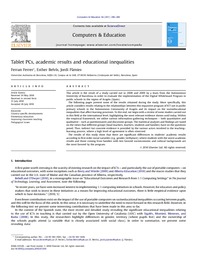Tablet PCs, academic results and educational inequalitiesFerran Ferrer, Esther Belvís, Jordi Pàmies
Erstpublikation in: Computers & Education 56 (2011) 280-288
|
 |
 Diese Seite wurde seit 2 Jahren inhaltlich nicht mehr aktualisiert.
Unter Umständen ist sie nicht mehr aktuell.
Diese Seite wurde seit 2 Jahren inhaltlich nicht mehr aktualisiert.
Unter Umständen ist sie nicht mehr aktuell.
 Zusammenfassungen
Zusammenfassungen
This article is the result of a study carried out in 2008 and 2009 by a team from the Autonomous
University of Barcelona in order to evaluate the implementation of the Digital Whiteboard Program in
public schools in the region of Aragón (Spain).
The following pages present some of the results obtained during the study. More specifically, this article considers results relating to the relationships between this expansive program of ICT use in public primary schools in the Autonomous Community of Aragón and its impact on the socioeducational inequalities that affect learning processes. To this end, we begin with a review of some studies carried out in this field at the international level, highlighting the most relevant evidence shown until today. Within the empirical framework, we utilise various information-gathering techniques – both quantitative and qualitative – such as questionnaires and discussion groups. The statistical analyses and findings are based on the views that different groups (head teachers, teachers, students and families) have on the questions posed. Thus, indirect but concrete evidence is provided by the various actors involved in the teaching– learning process, where a high level of agreement is often observed.
The results of this study show that there are significant differences in students’ academic results according to first order social variables (e.g., gender, birthplace), where students with the worst academic results and those coming from families with less favored socioeconomic and cultural backgrounds are the most favored by the program.
Von Klappentext im Text Tablet PCs, academic results and educational inequalities The following pages present some of the results obtained during the study. More specifically, this article considers results relating to the relationships between this expansive program of ICT use in public primary schools in the Autonomous Community of Aragón and its impact on the socioeducational inequalities that affect learning processes. To this end, we begin with a review of some studies carried out in this field at the international level, highlighting the most relevant evidence shown until today. Within the empirical framework, we utilise various information-gathering techniques – both quantitative and qualitative – such as questionnaires and discussion groups. The statistical analyses and findings are based on the views that different groups (head teachers, teachers, students and families) have on the questions posed. Thus, indirect but concrete evidence is provided by the various actors involved in the teaching– learning process, where a high level of agreement is often observed.
The results of this study show that there are significant differences in students’ academic results according to first order social variables (e.g., gender, birthplace), where students with the worst academic results and those coming from families with less favored socioeconomic and cultural backgrounds are the most favored by the program.
 Dieser Text erwähnt ...
Dieser Text erwähnt ...
 Fragen KB IB clear | ENpS: Verbessert ENpS den Lernerfolg? |
 Begriffe KB IB clear | kulturelles Kapital , One-to-One-ComputingOne-to-One-Computing |
 Dieser Text erwähnt vermutlich nicht ...
Dieser Text erwähnt vermutlich nicht ... 
 Nicht erwähnte Begriffe | Ein Notebook pro StudentIn (ENpS), Notebooks an Schulen |
 Zitationsgraph (Beta-Test mit vis.js)
Zitationsgraph (Beta-Test mit vis.js)
 1 Erwähnungen
1 Erwähnungen 
- Tablet use in schools - a critical review of the evidence for learning outcomes (B. Haßler, L. Major, S. Hennessy) (2015)


 Anderswo finden
Anderswo finden
 Volltext dieses Dokuments
Volltext dieses Dokuments
 |  Tablet PCs, academic results and educational inequalities: Artikel als Volltext ( Tablet PCs, academic results and educational inequalities: Artikel als Volltext ( : :  , 98 kByte; , 98 kByte;  : :  2021-03-21) 2021-03-21) |
 Anderswo suchen
Anderswo suchen 
 Beat und dieser Text
Beat und dieser Text
Beat hat Dieser Text während seiner Zeit am Institut für Medien und Schule (IMS) ins Biblionetz aufgenommen. Beat besitzt kein physisches, aber ein digitales Exemplar. Eine digitale Version ist auf dem Internet verfügbar (s.o.). Aufgrund der wenigen Einträge im Biblionetz scheint er es nicht wirklich gelesen zu haben. Es gibt bisher auch nur wenige Objekte im Biblionetz, die dieses Werk zitieren.










 Biblionetz-History
Biblionetz-History